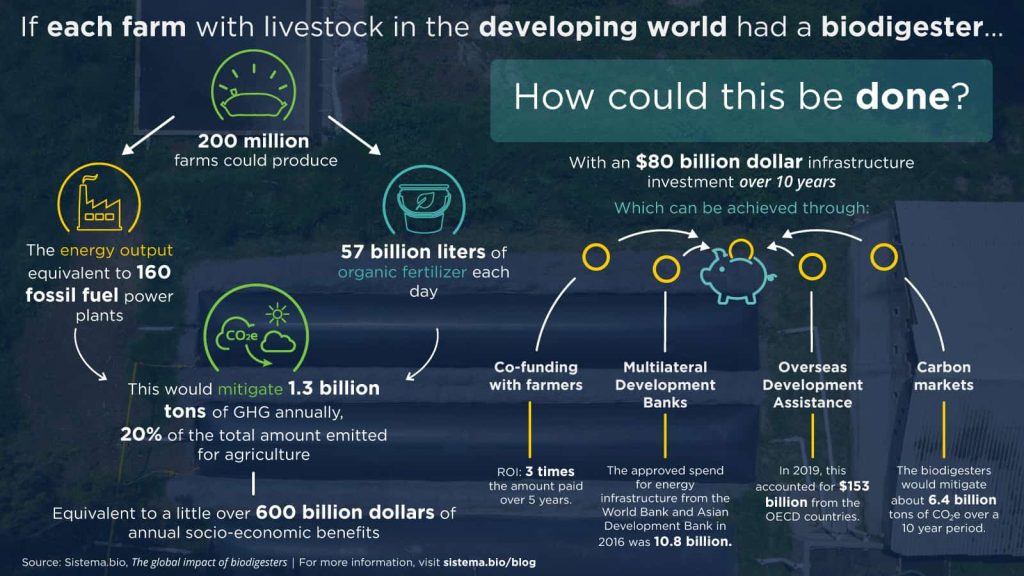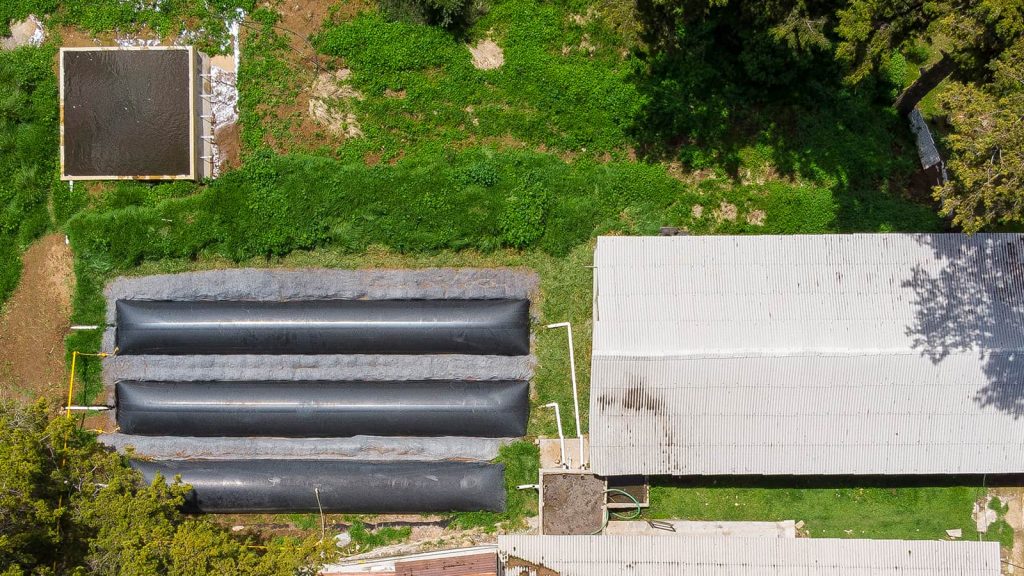
Graham Day
CFO
With an 80 billion dollars infrastructure investment we can create 600 billion dollars’ worth of socio-economic wealth annually, while regenerating soils, improving global food security and dramatically reducing greenhouse gas emissions. And we can prove it.
As CFO of Sistema.bio, I spend a lot of my time “in the numbers.” Checking consumer spending trends, understanding our client payments, analyzing unit profitability, and more things that you may not want to read about in a blog. But none of that matters if the big picture doesn’t make sense. With so many challenges on our planet and precious little time to deal with them, there’s simply no sense in trying to deploy solutions that don’t make sense at scale. So let’s get to the point:
What would happen if each farm with livestock in the developing world had a biodigester?
In short, we would have a massive decentralized power source of renewable biogas and organic fertilizer. Picture this: 200 million farms collectively producing the equivalent of what 160 fossil fuel power plants produce in electrical power.* On top of this, the farms would be creating 57 billion liters of organic fertilizer daily, sufficient to regenerate their soils and increase crop production by up to 30%. Taking into account averted fuel, averted chemical fertilizer and manure decomposition, this would mitigate 1.3 billion tons of greenhouse gases (GHG) annually, roughly 20% of the total amount emitted for agriculture.**
Over time, this would represent a titanic transition of wealth from energy and chemical companies to smallholder farmers. Lest we forget, these are the same farmers that currently produce over 80% of the food for their regional markets. Given the growing demands on food supply, increasing instances of extreme weather, and the shortage of extra land to develop, it’s crucial we make farmers more independent and resilient. By doing this, we are also helping tackle rural poverty and social injustice.
So how much would it cost?
At Sistema.bio, our high-quality, long-life biodigesters can be manufactured, delivered, installed and serviced for as little as $400 at scale.*** We know this because we have done it over 12,000 times since 2010. With 200m farms (fewer than 1% of which have biodigesters today), we are talking about $80 billion dollars spent over a decade or more. Is this a lot? Well, it depends. Consider the fact that it is about the same amount that the EU and USA spend on their fossil fuel industries annually through tax breaks and direct subsidies ($55B euros and $20B dollars). The IMF estimates that the collective effect of all fossil fuel subsidies is 38% more carbon emissions and 85% more deaths due to air pollution. So spending is in place, it is just, well, misplaced.

There are plenty of reasons why $80b of spending should not frighten us. Here are three:
- High ROI means the farms will pay a large portion of this. At Sistema.bio, we regularly run analysis on our clients’ household economics, which is the combination of savings from cooking energy and fertilizer, and increase in crop yield. For most clients, this equates to a payback period of well under 2 years. Over 5 years, they can expect a financial return of almost 3 times greater than the price they paid for it. In other words, the unit economics are strong enough so that much of the cost can be co-funded by the farmer. So, while $80b may be the overall price tag, there are many combinations of capital (loans, subsidies, etc.) that can get us there.
- High social value means that this should be an obvious public investment target. Infrastructure, particularly for energy, has consistently been built out by states throughout recent history. Especially through the 1960s-1980s, state-owned enterprises built generation, transmission and distribution capacity to electrify increasing swaths of countries throughout the Global South.**** There is no reason this can’t happen again for renewable, farm-based energy. After all, the social returns on any investment are extremely compelling. For instance, the Gold Standard estimates that a single CO2e ton reduction through biogas generates $465 in social value. By mitigating 1.3 billion tons of carbon, this is equivalent to a little over $600 billion dollars of annual socio-economic benefits. In other words, for each dollar invested, over 7 dollars are generated annually in health, livelihoods and climate value. Few technologies are on par with this level of return.
- Budgets and spending are already in place from development banks and aid agencies. There are three main sources of funding that could be set into action:
- Development financing. The Multilateral Development Banks finance billions of dollars’ worth of energy projects to support infrastructure, technical assistance and policy development. According to the World Resources Institute, the approved spend for energy infrastructure from the World Bank and Asian Development Bank in 2016 was 10.8b.
- Overseas Development Assistance (ODA). In 2019, this accounted for $153b from the OECD countries. Dedicating portions of these funds over time to biodigesters would ensure a steady deployment to the regions that need it most.
- Carbon markets. Reinvigorated markets alone could deliver major financing. The biodigesters would mitigate about 6.4 billion tons of CO2e over a 10 year period, representing $12 per ton. Many carbon purchasers, especially ones that have such a broad social impact, are willing to pay this amount. As such, significant capital could be sourced from public and private resources via carbon markets. This is especially true given the well recognized use of biodigesters as a tool against climate change (in Project Drawdown, among others).
Why now?
Along with all of the pain and loss caused by COVID-19, a thoughtful movement of “build back better” is taking hold. It combines the need for “shovel-ready” projects to create quality jobs, the need for solutions that address climate change, and the acknowledgment that the crisis has widened an already devastatingly large gulf between rich and poor.
At Sistema.bio, we firmly believe that there are few investment opportunities that have this kind of impact on farmer livelihoods, on climate, food supply and soil health. They can be targeted to regions or populations with modest amounts of financing and thoughtful mobilizations of partnerships between biodigester manufacturers, installers, farmer associations, and capital providers. Combined, these efforts will scale to a monumental deployment of infrastructure over time. We need to embrace this end goal, even if the numbers are daunting. After all, we no longer have the luxury to think small.
Sistema.bio is the most experienced biogas company in the world that works with smallholder farmers, and has been recognized by important institutions such as the World Economic Forum, the World Bank and the Ashden Clean Cooking Award.
References:
* Source: IFAD, AQPER, EIA and Sistema.bio calculations.
** Sistema.bio calculations based on the framework provided by the UNFCCC. It includes GHG mitigation from i) unprocessed animal waste, ii) energy otherwise consumed from LP gas, firewood or charcoal; and iii) energy otherwise consumed by the production and supply chain of chemical fertilizer.
*** Other technologies may be slightly cheaper or more expensive given the model, materials and quality.
**** See: Power in Mexico: A brief history of Mexico’s power sector and The History of Electricity Production in Africa.
